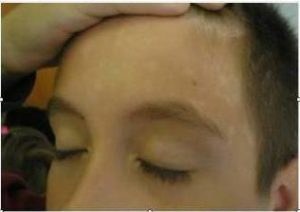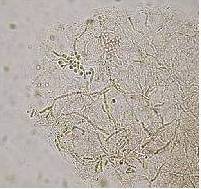Introduction
Pityriasis versicolor is a superficial infection of the stratum corneum caused by Malassezia yeasts (2011). Brzezinski et al (2010) reported in a high incidence especially in warm and humid areas; clinical manifestations include scaly hypopigmented or hyperpigmented macules in characteristic areas of the body: chest, back, abdomen and proximal extremities.
Case Report
We describe a case of Pityriasis versicolor (hypopigmented) localized only on the face in a 10-year-old boy (Fig. 1). The first diagnosis was vitiligo, the child underwent detailed and investigations about wide range in the Pediatric Hospital, the family was very anxious and the treatment proposed (phototherapy type UVB short wave (20 seances of UVB), emollients and topical steroids) was unsuccessful.

Figure 1: Hypopigmented Macules on the Face
A second opinion was asked, this time the child was addressed to a dermatologist and a simple scotch tape, taken from the frontal area and examined under microscope, concluded the final diagnosis: Pityriasis versicolor. The clinical and mycological results under antifungal therapy were excellent (Fig. 2).

Figure 2: Combination of Mycelium Strands and Numerous Spores Named “Spaghetti and Meatballs”
Discussions
Malassezia yeasts are found on the normal skin in 75-80% of health persons. Cabanes FJ et al (2011) describe that genus Malassezia is classified into 14 species: e.g.: Malassezia globosa, Malassezia restricta, Malassezia obtusa, Malassezia slooffiae, Malassezia sympodialis, Malassezia furfur and Malassezia pachydermatis. In work Shsh et al (2013) pityriasis versicolor the majority of cases are associated with M. furfur and M globosa.
Heat and humidity are the most important factors in inducing the infection explaining the high incidence of cases during summer. Occlusion of the skin by synthetic clothes may contribute also to the proliferation of the yeasts, although it was not the case in our young patient. Diabetes mellitus, immunosuppressive therapy or status, hyperhidrosis (constitutional or post physical exercises) are in favor of multiplication of the yeasts.
The face is a quite common localization of this disease in tropical climate. In Romania, country with temperate-continental climate, most cases of pityriasis versicolor are localized on the neck, trunk and limbs and rarely on the face, especially in children.
Diagnosis is mainly clinical based on hypopigmented and/or hyperpigmented macules with fine scales, distributed on special areas: neck, trunk and roots of limbs. Pruritus may be present in case of disseminated lesions associated with hyperhidrosis.
In the book by Chander (2002) hypopigmented lesions are explained by production of dicarboxylic acids (main component is azelaic acid) which inhibit DOPA tyrosinase and have cytotoxic effects on melanocytes. Hyperpigmentation is believed, in some authors’ opinion that is induced by increased thickness of keratin layer and by the presence of inflammatory cells that turn into stimulus for melanocytes.
Youngchim et al (2013) inform that M. furfur synthesizes melanin or a melanin-like pigment when grown in vitro and in vivo. and can be another explanation for the different colors seen on the skin in the presence of the yeasts( the term versicolor also highlits this clinical aspect).
Pityriasis versicolor is a chronic recurrent infection and left untreated can cause esthetical problems. Treatment is easy but despite the prophylactic measures recurrence is the rule.
Our case is interesting by the following arguments:
- The age of the patient, in general children are not very often diagnosed with Pityriasis versicolor;
- The localization of the lesions quite uncommon :the face;
- The difficulties in diagnosing the disease in some cases, wrong diagnoses can create anxiety among the family members,
- The rapidity and easy to perform method of putting in evidence the yeasts; the method can be applied in an ordinary room, with a small scotch band and a microscope and can also be used to control therapy.
References
Brzeziński, P. & Kaczmarek, D. (2012). ‘Mallasezia Folliculitis on the Neckn,’ Our Dermatology Online, 1 (2) 22-25.
Cabanes, F. J., Vega, S. & Castella, G. (2011). “Malassezia Cuniculi sp. nov., A Novel Yeast Species Isolated from Rabbit Skin,” Medical Mycology, 49 (1) 40-48.
Publisher – Google Scholar
Chander, T. (2002). ‘Textbook of Medical Mycology,’ 3rd ed. India: Mehta Publishers, Malasseziainfections, pp, 92—102.
Google Scholar
Shah, A., Koticha, A., Ubale, M., Wanjare, S., Mehta, P. & Khopkar, U. (2013). “Identification and Speciation of Malassezia in Patients Clinically Suspected of Having Pityriasis Versicolor,” Indian Journal of Dermatology, 2013 58 239.
Publisher – Google Scholar
Youngchim, S., Nosanchuk, J. D., Pornsuwan, S., Kajiwara, S. & Vanittanakom, N. (2013). “The Role of L-DOPA on Melanization and Mycelial Production in Malassezia Furfur,” PLoS One, 8 (6) e63764.
Publisher – Google Scholar




